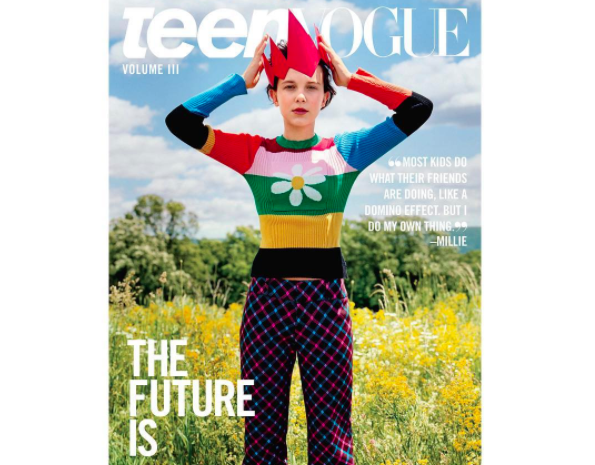What the death of print magazines means to millennials

According to Women’s Wear Daily, Condé Nast announced it will discontinue Teen Vogue’s print edition, which had only been publishing quarterly since fall 2016. Additionally, print editions of GQ, Glamour, Allure, Architectural Digest, Bon Appétit, W, and Condé Nast Traveler will be published less.
Condé Nast isn’t alone, either. Other prominent media networks are also experiencing similar cutbacks in print magazines. In August, New York City’s alternative weekly, the Village Voice, announced it will cease its print edition after six decades of distributing free papers, NPR explained. Additionally, a month later, Nylon announced they will no longer publish a print edition, WWD reported.
Although I’d been using the Internet since I was seven years old, I often read printed issues of Teen Vogue, and even had a print subscription for a few years.
It all started when I was 11 years old. My mom came home from the drugstore with mascara and the latest copy of the magazine in hopes of luring me away from my baseball card collection and Eagles jersey. It was clear her intent was to further feminize me, but it failed. I rejected the beauty conventions on the glossy pages, but their single multi-page feature always caught my attention, because it discussed societal problems like eating disorders, drug addictions, and domestic violence.
A post shared by Elaine Welteroth (@elainewelteroth) on Aug 15, 2017 at 5:15am PDT
Flash forward to earlier this month, when the most recent edition of Teen Vogue was delivered in my mailbox. I dropped my work responsibilities that morning to skip through it, reading it page-by-page without skipping a line. I swooned over the feature interview of Amandla Stenberg by Janelle Monae, a photo spread of different social demonstrations over the past year, a reflective essay on vogueing and LGBTQ youth, and a wellness piece about menstrual health.
When I read the news of Teen Vogue discontinuing its print edition on Thursday morning, it felt like a breakup of a 13-year relationship.
Teen Vogue is doing absolutely essential work right now and this is absolutely tragic https://t.co/DlZfpisxXa
— CRT (@StoryofEverest) November 2, 2017
I felt angry more than anything, because as publications invest more in branding, the quality of their content becomes less important.
Likewise, the reader becomes less important when compared to the sponsor.
In The Sponsor: Notes on a Modern Potentate, radio historian Erik Barnouw explains how pharmaceutical companies were among the biggest sponsors in broadcasting from 1930 onward. CBS hosted a medical advice show in the style of an audio advice column, promoting drugs to Great Depression-era audiences who couldn’t afford to visit a doctor. The show received 10,000 to 20,000 letters a week, which required a boxtop or “proof of purchase” for a specific product in order to be considered. Here, the goal wasn’t to actually provide credible information to news consumers, but to sell products, specifically drugs.
While CBS’s merchandising scheme seemed less transparent nearly a century ago, it’s naive to assume it won’t happen again. According to MediaShift, The New York Times has already been blurring the lines between sponsored and non-sponsored content.
Furthermore, this summer, Condé Nast spearheaded neuroscientific research, which concluded that sponsored content outperformed video advertising, according to a company press release. The media company has the finances to invest in business, but not in a print edition, which includes the labor required to produce it. If the trend of investing in branded content over quality journalism persists, then the media climate will suffer.
A post shared by Teen Vogue (@teenvogue) on Oct 11, 2017 at 8:19am PDT
Millennials won’t be the only ones to feel the loss of print media.
Gen-Zers particularly will (and already have) live in a media climate with significantly less printed materials, compared to the decades before. They’re the first generation of media consumers to rely on the Internet, especially on social media platforms, for news. When consumers rely more on the Internet — a place where anyone can create a news platform and say nearly anything they want — credible information is jeopardized. Digital media literacy isn’t integrated enough into our country’s education system to keep up with the changing media climate, either.
The elephant in the room is this: we’re learning about the folding of these print editions on the Internet, rather than in print itself. Unfortunately, we’ve seen here that media companies have failed to find a balance between print and online publishing. Many publications still strategized using pre-Internet conventions, which are destined to fail in the present age of media.
A post shared by Elaine Welteroth (@elainewelteroth) on Dec 19, 2016 at 4:48pm PST
But compared to any other publication, Teen Vogue seemed to hit it right, especially since hiring now Editor-In-Chief Elaine Welteroth (who is also the youngest EIC the publication has ever had). It’s viral political content from a left-wing and progressive perspective — with hit pieces like “Donald Trump Is Gaslighting America” by Lauren Duca and “White Male Terrorists Are an Issue We Need to Talk About” by Lincoln Anthony Blades — has helped the publication earn a “woke” reputation and the nickname of “Guillotine Vogue.” Many adult subscribers, like myself, bought subscriptions because their online content had become so powerful.
After all, if Teen Vogue can’t make print media happen, who can?

